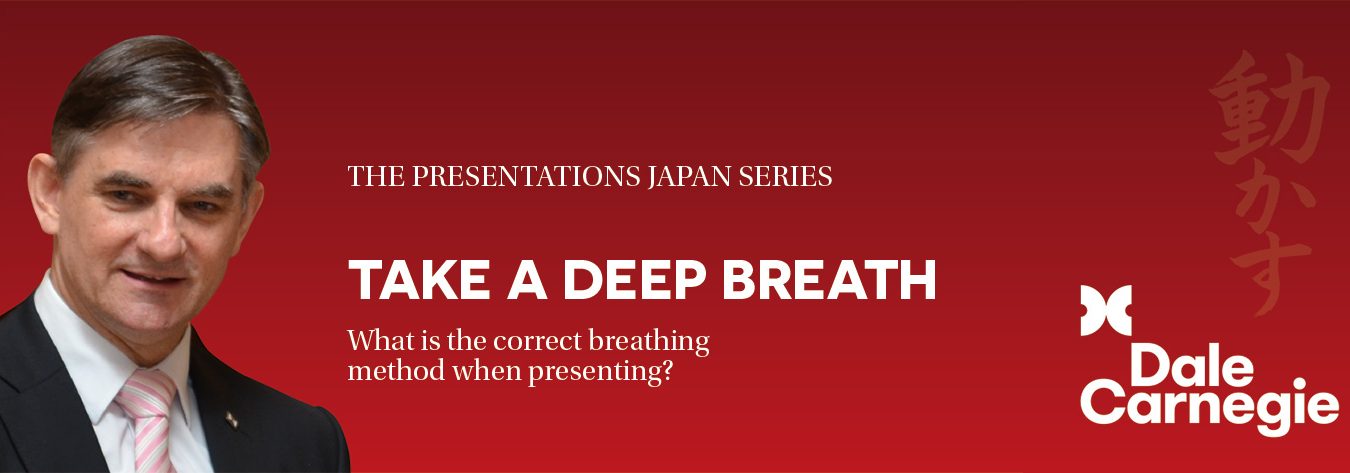 Breathing is such a natural act that, generally, we don’t pay it much attention. Somehow though, when we are giving a presentation, our breath control becomes a factor. One component is our nerves, which are driving the chemicals surging through our body, making our heart rate skyrocket. That, in turn, speeds up our shallow breathing.
Breathing is such a natural act that, generally, we don’t pay it much attention. Somehow though, when we are giving a presentation, our breath control becomes a factor. One component is our nerves, which are driving the chemicals surging through our body, making our heart rate skyrocket. That, in turn, speeds up our shallow breathing.
Other issues arise as a consequence, and we have mental white outs because we are not getting enough oxygen. We get lost, become panicky and come across as disorganised and flaky.
The projection of our voice is driven on the winds of exhalation, and lack of breathing power impacts audibility. We are squeaking out to the audience in this little voice that says, “I am not confident. I am not confident!”
We might find that our lack of breath control results in the final words of our sentences just dropping away to nothing. There is no opportunity to punch out a strong message because, vocally, we are just doing a disappearing act in front of the audience.
It could also be that we are becoming very breathy when we speak. It sounds similar to people who have respiratory illnesses and seem to be always gasping for air. Actually, they are, and so are speakers with no breath control. They simply can’t pull in enough oxygen.
The lack of breath gets transmitted to our cadence when we speak. Insufficient air means we are confined to short, breathy sentences and the lungs are not filled to capacity.
So how do we stop this and better supply our instrument—our wonderful voice? I am going to pass on what I have learnt from nearly 50 years of karate training, where breath control is absolutely vital. Controlling our nerves is a key part of breath control, because if we don’t, we are working at cross purposes with ourselves.
What you can do
One of the techniques for controlling our nervousness is to go through some deep-breathing exercises before we go on stage in front of the audience. We can do these seated or standing, and they don’t take very long.
Place both hands on your stomach and just touch lightly. As you breath in, imagine you need to fill the lungs from the bottom-most part of the diaphragm. To help us do this, we breathe slowly and deeply, and we can see if we are succeeding because the hands on our abdomen are starting to move forward. This pushing out of the abdomen is a good sign—it means we are doing the deep breath sequence correctly.
We reverse the process and slowly exhale, and the hands are slowly drawn back in. We need to do the breathing in slowly, because a bit too much force and speed here and we can become dizzy, as the flood of oxygen to the brain makes us feel lightheaded.
A new habit
This diaphragm breathing exercise is actually how we should be breathing all of the time, and I recommend you start the practice and make it your default habit. When we are in front of an audience, they cannot see the breathing rhythm, so there is no need to feel self-conscious. Every breath we take starts at the lowest point of the diaphragm and we sense our abdomen being pushed out and then being pulled back in.
Interestingly enough, if we lose the flow and our breathing suddenly begins from the very top of the chest, we will feel our pulse rate pick up, our chest tighten and our shoulders start to rise. This might happen at first, before we master deep diaphragm breath control. But don’t worry; just slow down the breathing, concentrate on the lower diaphragm and try to push your abdomen out with each inhalation. Once you do this, the cycle will re-institute itself and you will be getting plenty of air.
Correct breath control gives us the ability to make the tonal variations that keep command of our audience. We can bring power to words and build to crescendos when we want to emphasise particular key points. It also helps us to relax and look super composed when we are standing in front of people. That confidence is contagious, and our audience will buy what we are saying. And that is what we want, isn’t it?
Engaged employees are self-motivated. The self-motivated are inspired. Inspired staff grow your business, but are you inspiring them? We teach leaders and organisations how to inspire their people. Want to know how we do that? Contact me at greg.story@dalecarnegie.com







